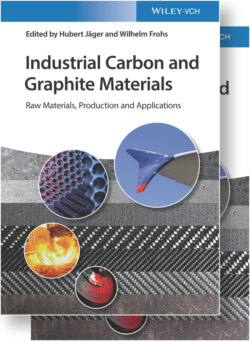Читать книгу Industrial Carbon and Graphite Materials - Группа авторов - Страница 266
6.1.1.1.4.1 Coal‐Tar Pitch
ОглавлениеCTP is the most common binder material for industrial carbons.
Coal tar is the by‐product of bituminous coal coking in by‐product recovery coke ovens for metallurgical coke production. Other by‐products are light oil, ammonia liquor, and coke‐oven gas. The tar is decanted from the ammonia liquor and fractionated in a tar distillery. Tar distillation columns are operated under atmospheric or vacuum conditions or operated continuous or batchwise. Continuous vacuum distillation is today the most frequently applied technique. Distillation temperatures reach around 700 K. The distillation gives about 50% pitch. Other products are light oils, naphthalene, and distillates such as anthracene oil.
Table 6.1.1.2 Typical pitch properties.
| Binder pitch | Impregnation pitch | Special binder pitch | |
|---|---|---|---|
| Softening point (Mettler) (°C) | 100–140 | 65–90 | 180 |
| QI (%) | 6–13 | 2–5 | 10–16 |
| TI (%) | 24–33 | 14–20 | 38–45 |
| Coking value (%) | 50–60 | 42–48 | >70 |
| Viscosity (150 °C), (mPa s) | 1206–4500 | 300–1200 | — |
CTP is a highly complex mixture of hundreds of different aromatic compounds. Even with most modern analytical methods like matrix‐assisted laser desorption/ionization time‐of‐flight (MALDI‐TOF) spectrometry, it is not possible to obtain additional information to explain differences in pitch behavior during mixing, forming, and baking [25].
Pitch specifications used in industry are a compromise of the most important characteristics. A pitch classification according to the solubility in various solvents has been developed [26]. Today the most common characteristic is the solubility in quinoline (quinoline insolubles [QIs]) and in toluene (toluene insolubles [TIs]). QIs contain all the solid contaminants and, if existing, also mesophase spheres (secondary QI), which can result from the distillation conditions or from thermal treatment of the pitch [27].
The content of primary and secondary QI influences the production behavior and the physical properties of the synthetic carbon artifact. High content in primary QI (>12 wt%) gives hard and isotropic carbon after baking [28, 29]. Consequently, the strength of the carbon material is improved, but the thermal expansion behavior and the thermal and electrical conductivity are deteriorated. The thermal stress resistance of such a carbon artifact suffers as improved mechanical properties may not compensate the poor electrical and thermal properties.
Secondary QIs negatively impact the interaction between the solid carbon filler and the binder pitch (wettability) during the mixing process. This can lead to losses in the apparent density of the artifact. Secondary QIs possess good graphitizability and give a binder coke with good electrical and thermal conductivity. The strength tends to lower values. The binder pitch demand during mixing increases with increasing QI content [30].
TIs are large condensed aromatic molecules that are important for the carbon yield of the pitch and the gluing of the carbon granules. The difference between TI and QI is the β‐resin content of TI with a molecular mass of the molecules above 400 (5–20 ring aromatics). Other specification properties are the softening point, the carbon yield, viscosity, and ash content. The viscosity–temperature curve is an important factor for mixing and forming and contains additional information that cannot be drawn from the correlation between softening point and viscosity [31].
Typical properties of CTP are summarized in Table 6.1.1.2. The softening point is limited in traditional mixing and forming equipment to about 120 °C (Mettler). High softening point binder pitches are preferably used for the production of molded graphite products. Closure of old coke‐oven batteries in Western Europe is responsible for a decrease in the QI content from about 13 wt% to below 8 wt%.
After the first baking the carbon artifact is rather porous due to the losses of volatile matter. To achieve the requested final product properties, the baked material is impregnated with an impregnation pitch or resin. The number of impregnation steps and subsequent rebaking of the carbon material depends on the desired properties. In most cases one impregnation step is sufficient. The impregnation must be thorough, homogeneous, and carried out within reasonable time. This requires a low pitch viscosity and good wettability (low surface tension) of the solid carbon under impregnation conditions [32, 33]. Other important factors are the QI content and the molecular size distribution. During the impregnation process, a filtration cake builds up on the surface, which is formed by QIs and large planar molecules. This filtration cake may stop further impregnation when it cannot be penetrated by the impregnation pitch any longer. To predict the quality of an impregnation pitch, a simple test has been introduced in industry, which simulates the impregnation process by passing the impregnation pitch under defined temperature and pressure conditions through a porous solid material. This solid material is of carbon or a metal with defined porosity. The weight of the impregnation pitch that passes through this porous material is measured vs. time. Impregnation pitches are lower in softening point and QI content than binder pitches. To achieve this, suitable tars with QI contents below 2 wt% must be selected.
Due to the soft distillation conditions of impregnation pitch, it remains rather reactive and changes during storage and transportation under temperatures of around 460 K and under impregnation conditions in the process. These polymerization and polycondensation reactions, so‐called aging, change the quality of the pitch and make special control necessary.
